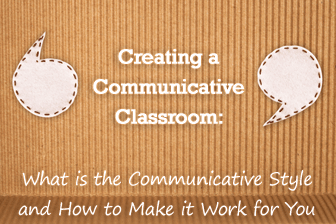
The Communicative Method is all about communication.
Communicative language teaching makes use of real-life situations that necessitate communication. The teacher sets up situations that students are likely to encounter in real life. Unlike other methods of language teaching, which rely on repetition and drills, the Communicative Approach focuses more on spontaneous activities and practice, which provides varied outcomes depending on student reactions and responses. The real-life simulations differ from day to day so that students' motivation to learn comes from their desire to communicate in meaningful ways about significant topics. This method is focused upon students being able to communicate in a conscious way, taking into account real experiences. See how you can make the Communicative Style work for you.

How to Make the Communicative Method Work For You
-
1
Utilize Creativity
Utilizing the Communicative Method comes more naturally than that of any rote system devised to keep students following the book at all times and memorizing all the material they can. This method is a way for both teacher and students to get the most out of the classroom experience. Utilize your own creativity to create activities and exercises that would otherwise have your students either moaning or snoring. Put life into your lessons by remembering that each explanation or point needs to be followed by some kind of hands-on practice. Doing it this way pushes students to display comprehension of the point by participating. It also gives them the opportunity to work out the kinks naturally and they can begin to formulate their own questions. This method also should facilitate a safe learning environment where students are comfortable, aspire to speak and want to participate in activities that strengthen their abilities.
-
2
Tests and Drills
You can still incorporate a small amount of drilling and testing. It is good to integrate quizzes and tests, but even those can be created communicatively. Base your tests on real-life situations and practical combinations of fill in the blank, multiple choice, true and false and essay. There are some topics, like irregular past tense verbs, that absolutely need to be drilled. You can create drills that are more like games. Play Tic Tac Toe or four in a row with verbs instead of having them just memorize words. They will need to memorize the verbs, but they also need practice using them in spoken and written English. Find ways to makes drills fun and engaging and students will respond with increased involvement as well as more highly developed skills.
-
3
Use Games and Interactive Practice
The Communicative Style gets the teacher out of the forefront and has the students doing the real nitty-gritty work. You explain the grammar. You guide the students in understanding and then you come up with the ideas of how they have fun practicing it. You moderate. The students should get plenty of floor time and should be the ones speaking most of the time. There are lots of websites out there to give you ideas about games you can play, activities you can incorporate, ways to break up lessons into activities. Think about simulating real life. Have the students do role plays that are guided but unscripted. Give them puzzles that take language and communication to work out. Incorporate competition and team oriented games as well as group and pair work. Combine students in different ways and provide variety through activities. Try new things and don’t be afraid to take some risks in generating original and entertaining ways to bring language to life.
The Communicative Method is the best way to teach language.
You will find that it opens up a whole new world in which you have a lot more freedom and creativity. It will benefit your students by giving them a safe venue in which to experiment and learn more in a shorter period of time. I have both taught with it and studied with it, and it provides abundant results and connections in the classroom that you just cannot achieve in any other way!
P.S. If you enjoyed this article, please help spread it by clicking one of those sharing buttons below. And if you are interested in more, you should follow our Facebook page where we share more about creative, non-boring ways to teach English.







